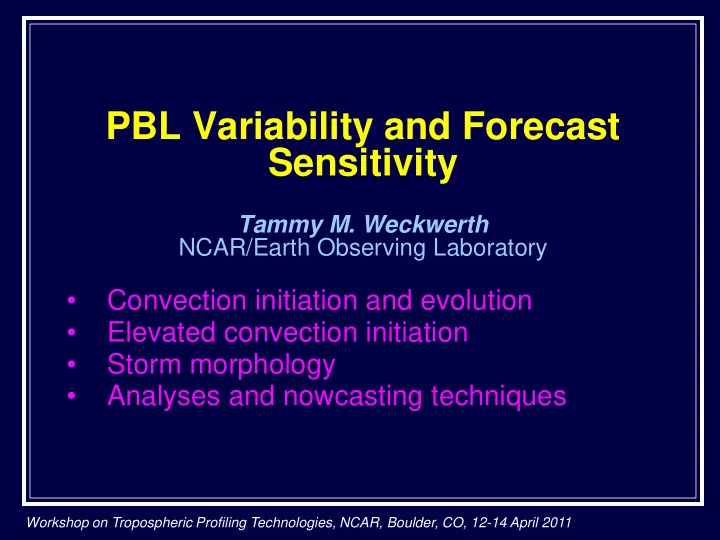

PBL Variability and Forecast Sensitivity Tammy M. Weckwerth NCAR/Earth Observing Laboratory • Convection initiation and evolution • Elevated convection initiation • Storm morphology • Analyses and nowcasting techniques Workshop on Tropospheric Profiling Technologies, NCAR, Boulder, CO, 12-14 April 2011
Surface-Based Convection Initiation Wilson et al. (1997)
Surface Horizontal Mass Convergence a. SHMC max with tropospheric circulation and deep convection b. SHMC max with shallow convection due to subsidence or capping inversion c. SHMC max near change in CBL depth d. HMC above CBL Convergence field is Banacos and Schultz (2005) important
Shear Balance Shear balances gust No shear; gust front front and produces moves away from optimal situation for storm long-lived systems From Weisman after Rotunno et al. (1988)
Steering Level Winds • Vertical, deep updrafts • Boundary motion ~ storm motion • Supported by Moncrieff and Miller (1976) and Weisman and Klemp (1986) Full wind profiles Wilson and Megenhardt (1997) important
Boundaries Modify Local Stability Wilson et al. (1997)
CI Along Dryline • Intense, deep mesoscale lifting - CI • Require w ht > LFC Need depth and amount of moisture to forecast CI Ziegler and Rasmussen (1998)
Cold Front and Dryline CI •Cool, moist air capped by inversion •CI where q bulges, no CI cap •CI not continuous along DL NW SE Warm, Cool, moist, S flow Cool, moist, N flow dry, SW Murphey et al. (2006) flow
Dryline CI •Leandre II wv DIAL showed moisture variations •Caused by misocyclones •Near W max and CI High-resolution 3D structure 8 km of q, T, winds important Murphey et al. (2006)
CI – 24 May 2002 CI Cold, dry Warm, moist • No CI at triple point! W E • CI east of TP • Deeper moist air E CI • Deeper CBL (aerosol plume) Less stable ( θ v vertical • gradient reduced) • Wave or solenoidal DL circulation? Detailed 3D structure essential to improved understanding Wakimoto et al. (2006)
CI by SBF and Rolls • Rolls lifted up at SBF intersections • Deeper, stronger updrafts and clouds at intersection points – increased likelihood of CI • Simulated by Rao et al. (1999) and Dailey and Fovell (1999) Need 3D structure of kinematics and thermodynamics Atkins et al. (1995)
T and q Sensitivity to Thunderstorm Occurrences CI • 4 years of warm Non- Thunderstorm Thunderstorm season days days • Non-synoptically T forced systems in Taiwan T • Warmer (1 °C) and T d T d moister (1-3 °C) on thunderstorm days compared to non- thunderstorm days Lin et al. (2011)
T and q Sensitivity to CI • CI related to surface Integrated CI temperature dropoff Integrated rain water rainwater • Storm strength related to surface moisture dropoff • CBL variations of 1 °C and 1 g kg -1 are Storm strength important for CI Crook (1996)
Observed Moisture Variability • Moisture variations of 1.5 g kg -1 observed between roll updrafts and downdrafts • Representative- ness of soundings? Weckwerth et al. (1996)
CI and AERI Stability Indices x Lamont Vici x x Purcell x x x x x • Multiple severe storms around AERIs • CAPE increased and Feltz and CIN decreased with CI: Mecikalski erosion of cap (2002) • Valuable info but not sufficient
A key factor in nocturnal convection is the depth of the moist inflow, which can be aloft Sounding Susceptible to Surface- Sounding Susceptible to Elevated Based Convection Convection DVN (0000 UTC 9/12/2000) GRB (0000 UTC 9/12/2000) From Trier et al. 2002, abstract 130, Reading QPF meeting
Elevated Convection Initiation Sounding Susceptible to PBL- Sounding Susceptible to Elevated Based Convection Convection Courtesy Jim Wilson (NCAR)
Elevated Convection Initiation • Stable surface layer • Height of max CAPE: 0.6-1.3 km • No surface boundary • Further CI due to bore • Morning CI due to gust front • Elevated CI transitioning to sfc CI – important for generation of long- lived MCSs (e.g., Carbone et al. 2002) Need high-res 3D observations Marsham et al. (2011) of wind and stability
Storm Morphology Affected by Changes in Shear • 1.5 km ARPS grid spacing • 4-hr simulation No change in shear produces cellular convection Changing shear: Quasi- linear convection with a bow echo Richardson et al. (2007)
Storm Morphology Affected by Changes in Inversion Layer • 1 km grid spacing • Time-varying inflow lateral BC prescribed from meso analysis with increasing stability - accurate • Homogeneous simulation produces MCS – not accurate Ziegler et al. (2010)
Lagrangian Analysis • Assimilate multiple datasets using 3D radar wind field • Output 3D fields of q, θ and θ v • Study boundary structures and CI Ziegler et al. (2007a; 2007b)
VDRAS • Variational Doppler Radar Analysis System • 4DVAR based on cloud-scale model • Assimilates Z, V r + sfc observations • Produces 1-3 km T, q and wind fields • Excellent tool for nowcasting Sun and Crook (1997, 1998)
NCAR Autonowcaster System • Produces 0-1 hr time and place specific forecast • Expert system utilizes fuzzy logic • Ingest multiple data sets • Ingest NWP output • 4-D Variational Doppler Radar Analysis System (VDRAS) • Extrapolates radar echoes • Forecast storm initiation, growth and dissipation • Algorithms derive forecast parameters based on the characteristics of the boundary layer, storms and clouds. Mueller et al. (2003)
Example of Auto-Nowcaster Initiation Forecast 1 hour forecast Verification Initiation nowcasts extrapolation nowcasts Courtesy Jim Wilson (NCAR)
Closing Remarks • Important to continuously sample small-scale variations of temperature, moisture and wind • Satellite imagery and scanning radars provide the big picture • Integration of data sets is required to improve understanding of mesoscale dynamics and improve forecasting skill • High-resolution data assimilation of multiple datasets essential to provide 3D, time-varying temperature, moisture and wind fields
Thank you for your attention.
Recommend
More recommend